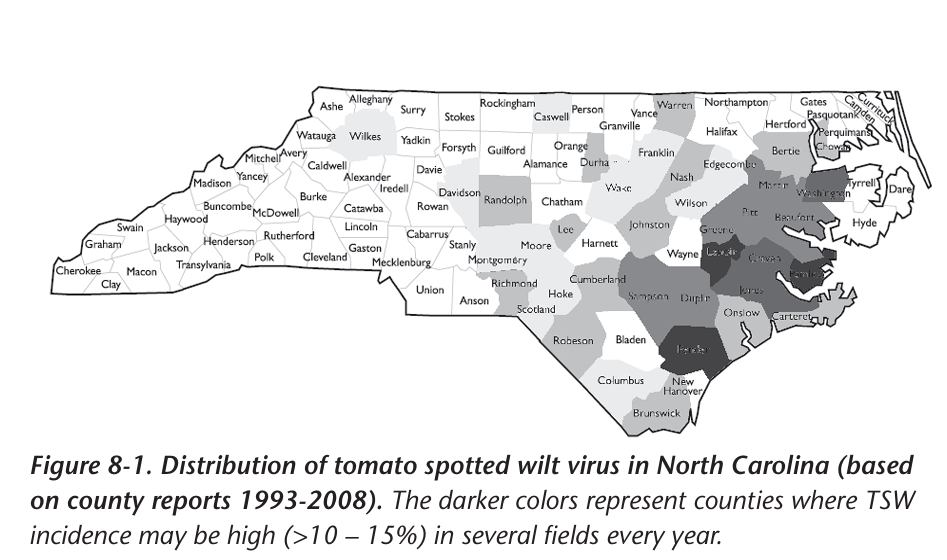Tool Restored: Thrips Flight and TSWV Risk Assessment Report – May 7, 2025
go.ncsu.edu/readext?1071482
en Español / em Português
El inglés es el idioma de control de esta página. En la medida en que haya algún conflicto entre la traducción al inglés y la traducción, el inglés prevalece.
Al hacer clic en el enlace de traducción se activa un servicio de traducción gratuito para convertir la página al español. Al igual que con cualquier traducción por Internet, la conversión no es sensible al contexto y puede que no traduzca el texto en su significado original. NC State Extension no garantiza la exactitud del texto traducido. Por favor, tenga en cuenta que algunas aplicaciones y/o servicios pueden no funcionar como se espera cuando se traducen.
Português
Inglês é o idioma de controle desta página. Na medida que haja algum conflito entre o texto original em Inglês e a tradução, o Inglês prevalece.
Ao clicar no link de tradução, um serviço gratuito de tradução será ativado para converter a página para o Português. Como em qualquer tradução pela internet, a conversão não é sensivel ao contexto e pode não ocorrer a tradução para o significado orginal. O serviço de Extensão da Carolina do Norte (NC State Extension) não garante a exatidão do texto traduzido. Por favor, observe que algumas funções ou serviços podem não funcionar como esperado após a tradução.
English
English is the controlling language of this page. To the extent there is any conflict between the English text and the translation, English controls.
Clicking on the translation link activates a free translation service to convert the page to Spanish. As with any Internet translation, the conversion is not context-sensitive and may not translate the text to its original meaning. NC State Extension does not guarantee the accuracy of the translated text. Please note that some applications and/or services may not function as expected when translated.
Collapse ▲To help growers determine the potential of management practices for TSWV, we have created step-by-step guides on how to use the Tobacco Thrips Flight and TSWV Intensity Predictor to create Current Year TSWV Risk Assessments and Historical TSWV Predictions. Growers are strongly encouraged to create their own models using the information from their fields and season dates to plan for Tomato Spotted Wilt Virus (TSWV) management.
Predictive models for the locations below indicate lower estimated TSWV Risk this year than in 2024, except for the Whiteville area. The estimated TSWV risk for these locations is 3.6% for Kenly, 5.7% for Kinston, 6.6% for New Bern, and 10.7% for Whiteville. Thrips encountered at this moment in tobacco fields at Kenly, Kinston, and New Bern belong to the 2nd generation. The 3rd generation of tobacco thrips began to disperse in Whiteville this week (estimated May 5), and it is expected to start dispersing on May 19 in Kenly, May 12 and 11 in Kinston and New Bern. The 4th generation of thrips is expected to begin dispersing approximately two weeks after, in early June.
Because the third AND fourth generations of tobacco thrips are the ones that typically transmit the most TSWV, seedlings transplanted in late April (3rd and 4th week) are more at risk of TSWV infection than the ones transplanted before mid-April. Be aware that it takes approximately four weeks from the time a plant is infected with TSWV until the symptoms appear. Thus, symptoms of TSWV infection will probably show up in the next one or two weeks for early planted fields (1st-2nd week of April).
A greenhouse application of imidacloprid alone or in combination with Actigard® at transplant or greenhouse is recommended to minimize potential losses to TSWV. If imidacloprid was not applied in the greenhouse before planting or at transplant, foliar applications of imidacloprid can be can conducted to product against TSWV. If foliar applications of Actigard® are being considered (post transplant), the sooner plants are treated the better since it takes a few days for the product to be effective and can provide protection for ~two weeks (depending on environmental conditions). Treatment in addition to standard insecticides is probably not required for areas with a history of <10% TSWV incidence. See the NC Agricultural chemicals Manual and the NC Flue Cured and Burley Tobacco Guide for details on TSWV management practices.
This update was compiled based on Thrips Flight and TSWV Risk Assessments conducted for the four key tobacco-growing locations in NC included below. These models were created assuming no insecticide treatment and including the average historical TSWV incidence for each location as listed below (Fig. 8.1 modified from Mina, 2011).
- Kenly is a relatively low TSWV risk site (typically less than 8%), situated within large acreage production areas in Johnston and Wilson Counties.
- Kinston is a moderate TSWV risk site (typically less than 10%) in Lenoir County and also houses the NCDA & CS Cunningham Research Station, where extensive tobacco research is conducted.
- New Bern is a higher TSWV risk site (typically above 10%) in Craven County.
- Whiteville is a moderate to high TSWV risk site (around 8% or above 10%) in Columbus County and also houses the NCDA & CS Border Belt Tobacco Research Station , where tobacco research is conducted.

Figure 8-1. Distribution of tomato spotted wilt virus in North Carolina (based on county reports 1993-2008). The darker colors represent counties where TSW incidence may be high (>10-15%) in several fields every year.
The models used for this summary are attached below for your reference. In order to get the most accurate risk assessment, we recommend you enter your own farm data into the TSWV and Tobacco Thrips Risk Forecasting Tool and check for any updates frequently.
More Information


